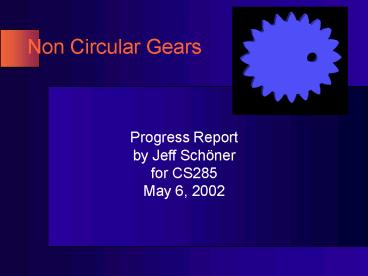Non Circular Gears - PowerPoint PPT Presentation
1 / 11
Title: Non Circular Gears
1
Non Circular Gears
Progress Report by Jeff Schöner for CS285 May 6,
2002
2
Review
- Circular gears are well-understood. Non-circular
gears are not, which makes them interesting. - I intended to produce 3 sets of NC gears.
- Original purpose art with industrial side-effects
3
Achievements
- A general system that can generate elliptical
(and perhaps other) gears. - Python program that produces SLF
- Output passes the SIF test.
- STL ready for first fabrication.
4
Problems
- Ellipses do not have a closed form description of
their perimeter or arc length. - Placing teeth is dramatically complicated.
- Approximations How good do they need to be?
- Not much literature on NC gears.
- Only one chapter in one book in the library.
- Most gear texts discuss only how to make gears
using existing machines. - Hard to find a mathematical description of
involute curves.
5
More problems
- Original naive algorithm did not work.
- Rolling distance must be taken into account as
well as angular rotation. - Algorithm could be (and may still be) reworked.
- However, generating the shape description is not
nearly as difficult as creating an accuprate
boundary representation. - Designing general software makes everything more
complicated at first.
6
Ellipse Solutions
- Representation
- Several parameters
- Two polar representations
- With one, placing hole is easier.
- With the other, computing curvature easier.
- Maxima makes computing nasty derivates easier,
although mistakes crop up in the data entry.
Images from http//mathworld.wolfram.com, Wolfram
Research, makers of Mathematica
7
Ellipse Solutions Placing Teeth
- Perimeter and arc length contain elliptic
integrals. - In math, just use E(t,k).
- In a computer, you need rational values.
- Convert ellipse into a n-sided polygon.
- Gears don't really have to be curved.
- In fact, must be a bunch of triangles in the end.
8
Ellipse Solutions Placing Teeth
- Algorithm
- Approximate the perimeter using a method like
Ramanujan's - Divide by the number of teeth to get circular
pitch. - Set delta theta to something like 0.001
- Walk in delta theta-sized steps along the
perimeter, marking section boundaries. - Compute error. Refine value linearly.
- Repeat until no error or values cycle.
9
What remains to be done?
- Fix some tooth orientation issues that don't
occur with elliptical gears, but perhaps others. - Teeth need to be rotated away from the center of
the gear. - Design 2 more sets of gears
- Ellipse driving an oval
- Oval driving an oval
- FDM some real parts and make sure they work.
- All original goals still seem do-able.
10
Conclusions I've learned...
- Gears may be well-understood, but textbooks are
typically not very concerned with theory. - Current methods work, so new ones not in demand.
- I don't know enough about mathematics as I'd
like. I've forgotten a lot too. - A lot about ellipses, curvature, radii of
curvature, involute curvers (circular and
otherwise). - Where (and how) standard circular gear theory can
be generalized and where it can't.
11
Conclusions What would I do differently?
- Structured my checkpoints differently.
- Learning theory of shapes and teeth proved to be
not as useful as I thought. - Making the software took much more time than
expected. - Coding approximations proved to be time
consuming. - Focus more on boundary construction than on polar
equation generation.































